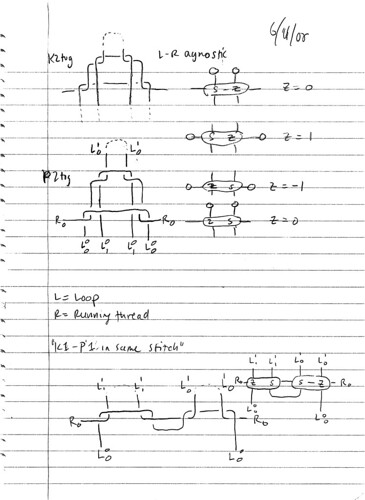
Saturday, August 30, 2008
Friday, August 29, 2008
Plan B for world entrelac domination
 |
| From Knitting Diag... |
Thursday, August 28, 2008
Wednesday, August 27, 2008
30-square entrelac cube starting from an edge
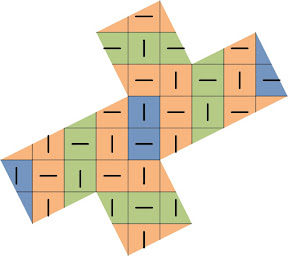 This is a model of a cube where the entrelac squares lie askew of the cube's edges. I have colored it in such a way that you could knit it with an interesting pattern. The knitting starts at the center and goes outward: 2 blue squares, then a ring of 8 orange squares, then a ring of 10 green squares, 8 orange squares and 2 blue squares (2-8-10-8-2). Each "ring" can be knitted with a single length of yarn.
The darker lines on the squares show the grain of the knitting.
Alas, it turns out that this is impossible to knit with the constraints I have been using for 3-d entrelac, that is, only one "seam" at the very end (where you have to graft the top of a square to a previously knitted square's side).
After thinking about this some more, I realize that this cube could be knitted with two pieces of yarn, knitting half the squares with one and half with the other. Knitting with 2 pieces of yarn avoids the problem mentioned above, and enables knitting this with only one of the grafted seams.
This is a model of a cube where the entrelac squares lie askew of the cube's edges. I have colored it in such a way that you could knit it with an interesting pattern. The knitting starts at the center and goes outward: 2 blue squares, then a ring of 8 orange squares, then a ring of 10 green squares, 8 orange squares and 2 blue squares (2-8-10-8-2). Each "ring" can be knitted with a single length of yarn.
The darker lines on the squares show the grain of the knitting.
Alas, it turns out that this is impossible to knit with the constraints I have been using for 3-d entrelac, that is, only one "seam" at the very end (where you have to graft the top of a square to a previously knitted square's side).
After thinking about this some more, I realize that this cube could be knitted with two pieces of yarn, knitting half the squares with one and half with the other. Knitting with 2 pieces of yarn avoids the problem mentioned above, and enables knitting this with only one of the grafted seams.
monster entrelac plan
OK, here I got a little crazy. This is the diagram for a 3-D entrelac shape I knitted for my first nephew. It knits up to be the shape of a cube surrounded by six other cubes. That shape has 5 time 6 equals 30 faces. Each face is made up of 4 half-squares, which gives a total of 60 squares.
It would definitely make more sense with a picture of the finished result. I'll work on that.
Tuesday, August 26, 2008
Another way to knit a cube in entrelac.

- Knit the 1st square. End on a wrong-side row. Do not break yarn.
- Cast on (or knit onto scrap yarn stitches cast onto the left needle) and knit the 2nd square. Attach the left side of the 2nd square to the top of the 1st square as you go. End on a right-side row.
- Pick up stitches on the left side of the 1st square (from the top down) and knit the 3rd square, attaching the right side to the top of the 2nd square as you go. End on a right-side row.
- Pick up stitches on the left side of the 3rd square (from the top down) and knit the 4th square, attaching the left side to the bottom of the 1st square as you go. End on a right-side row.
- Pick up stitches on the right side of the 1st square (from the bottom up) and knit the 5th square, attaching the left side to the bottom of the 2nd square and the right side to the top of the 4th square as you go. End on a right-side row.
- Pick up stitches on the right side of the 2nd square (from the bottom up) and knit the 6th square, attaching the left side to the top of the 3rd square and the right side to the top of the 5th square as you go. End on a wrong side row, leave a long tail of yarn. Stuff the cube if you like. Graft the top of the 6th square to the right side of the 4th square.
How to knit a cube in entrelac from corner to corner
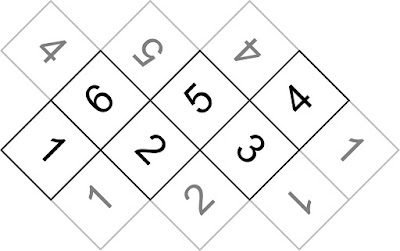 Explanation:
Explanation:
- Knit the 1st square. End on a wrong-side row.
- Pick up stitches on the right side of the 1st square (from the top down) and knit the 2nd square. End on a wrong-side row.
- Pick up stitches on the right side of the 2nd square (from the top down) and knit the 3rd square. Attach the right side of the 3rd square to the bottom of the 1st square as you go. End on a wrong-side row.
- Pick up stitches on the left side of the 1st square (from the top down) and knit the 4th square. Attach the left side of the 4th square to the top of the 3rd square as you go. End on a right-side row.
- Pick up stitches on the left side of the 3rd square (from the top down) and knit the 5th square. Attach the left side of the 5th square to the top of the 3rd square and the right side of the 5th square to the top of the 2nd square. End on a right-side row.
- Pick up stitches on the left side of the 2nd square (from the top down) and knit the 6th square. Attach the left side of the 6th square to the top of the 1st square and the right side of the 6th square to the top of the 5th square. End on a wrong side row, leave a long tail of yarn. Stuff the cube if you like. Graft the top of the 6th square to the right side of the 4th square.
Tuesday, August 12, 2008
monster entrelac
This is one of those crazy 3-d entrelacs. When I was done knitting 60 squares, I had a cube with cubes on all faces. Each face was made up of 4 half-squares. I guess you had to be there. I think I'll knit another one. This one was made with 2 colors... I gave it to my nephew and called it a "baby-shape" because you could hold onto it with your little baby hands.
Thursday, August 07, 2008
knitted entrelac triangular prism diagram
Each square has a number showing the order it's knitted in. The diagonal arrow show the path the yarn takes into and out of the square.
Each square in the diagram is surrounded by other squares representing knitted squares that already exist (the number is not in parentheses, and it's a lower number) or squares that will be knitted later. The orthogonal arrows show the direction of knitting for each square except for the one you're currently knitting, which you're knitting from bottom to top.
To start each square, you'll either be knitting onto a scrap-yarn provisional cast-on (P. C. O), for example in squares 1, 2, 4, or picking up stitches from the sides of other squares. Picking up stitches is represented by little hatch marks inside the square you're working on.
And for every square after the first square, you'll also be attaching a side of the current square to the live stitches of one square that came before. This is denoted with little hatch marks that go along one of the sides of the square you're working on, but the hatch marks are outside the square. This is done in typical entrelac fashion, by working the first or last stich of a row together with one of the live stitches from another square.
Occasionally, and this is to be avoided whenever possible, you have to attach the live stitches of the square you just knitted to the side of another square previously knitted. This is indicated by a wavy line above the top of the square you just knit. The only way I've figured out how to do this short of grafting is to hold one live stitch available from the previously knitted square. You'll see this with a notation "leave loose." If that stitch is a live stitch when the time comes to attach the later square, you can ladder down that edge stitch and chain it up again, attaching the live stitches as you go.
notation for knitting stitch topology
Here's another example of where I thought I was being clear, but not so much. I was trying to figure out how to express that a knit stitch is the same as a purl stitch.
My flash of insight about knitting, which may very well be obvious to most of the world, is that knitting is about the relationship between loops and loops. A loop is pulled through another loop, which creates two double-twists, which is what I was trying to express here, in June of 2005.
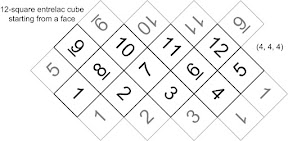

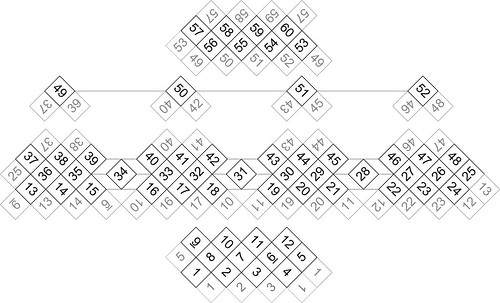
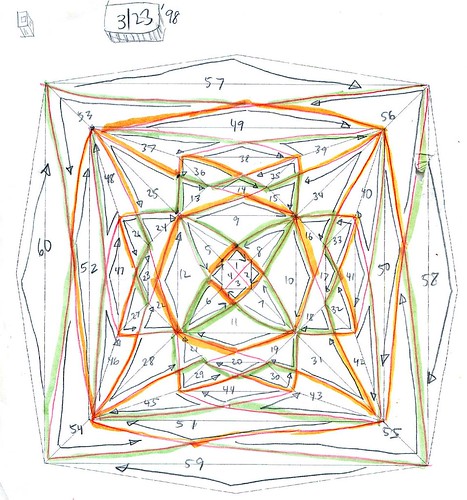
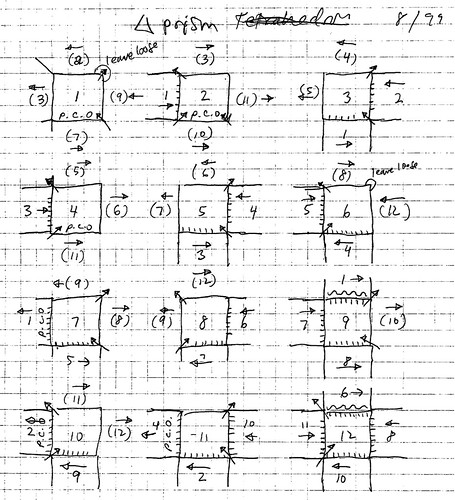
![Reblog this post [with Zemanta]](http://img.zemanta.com/reblog_e.png?x-id=efd23a35-14e9-4b05-9555-d5ad22f2b59e)
